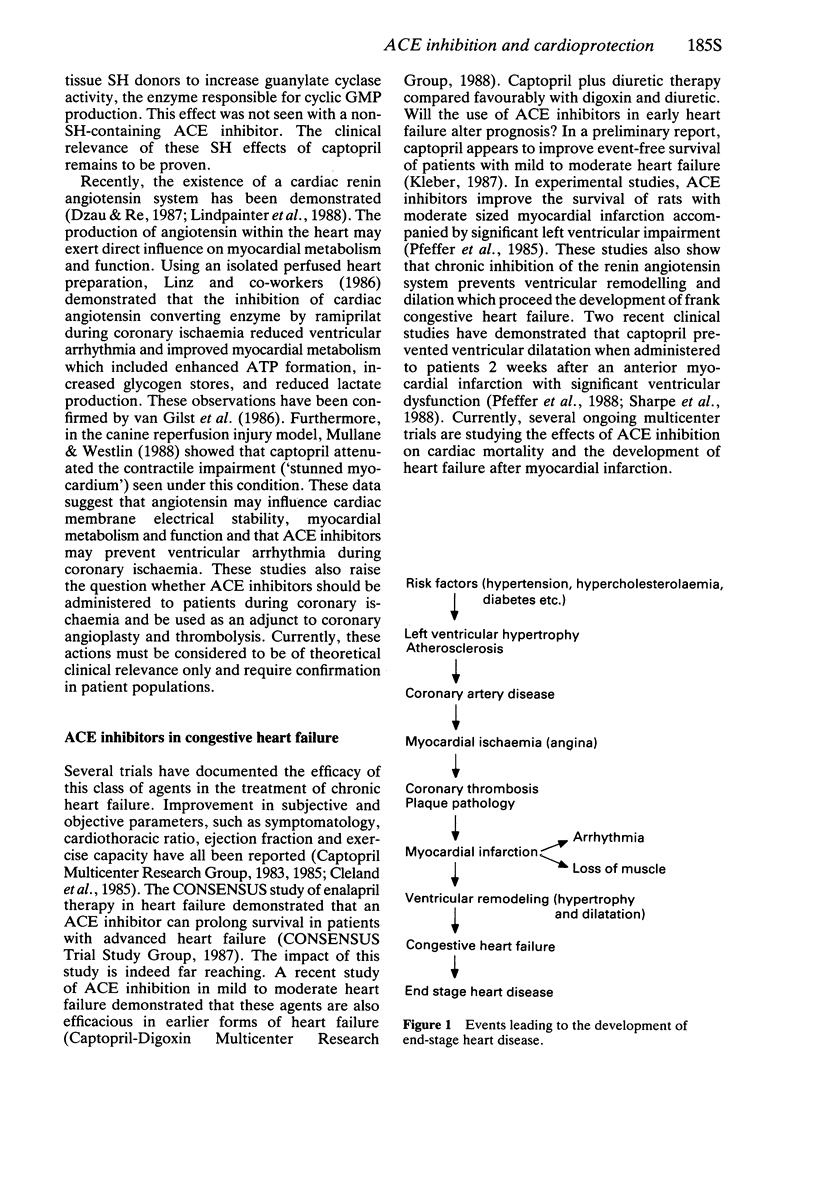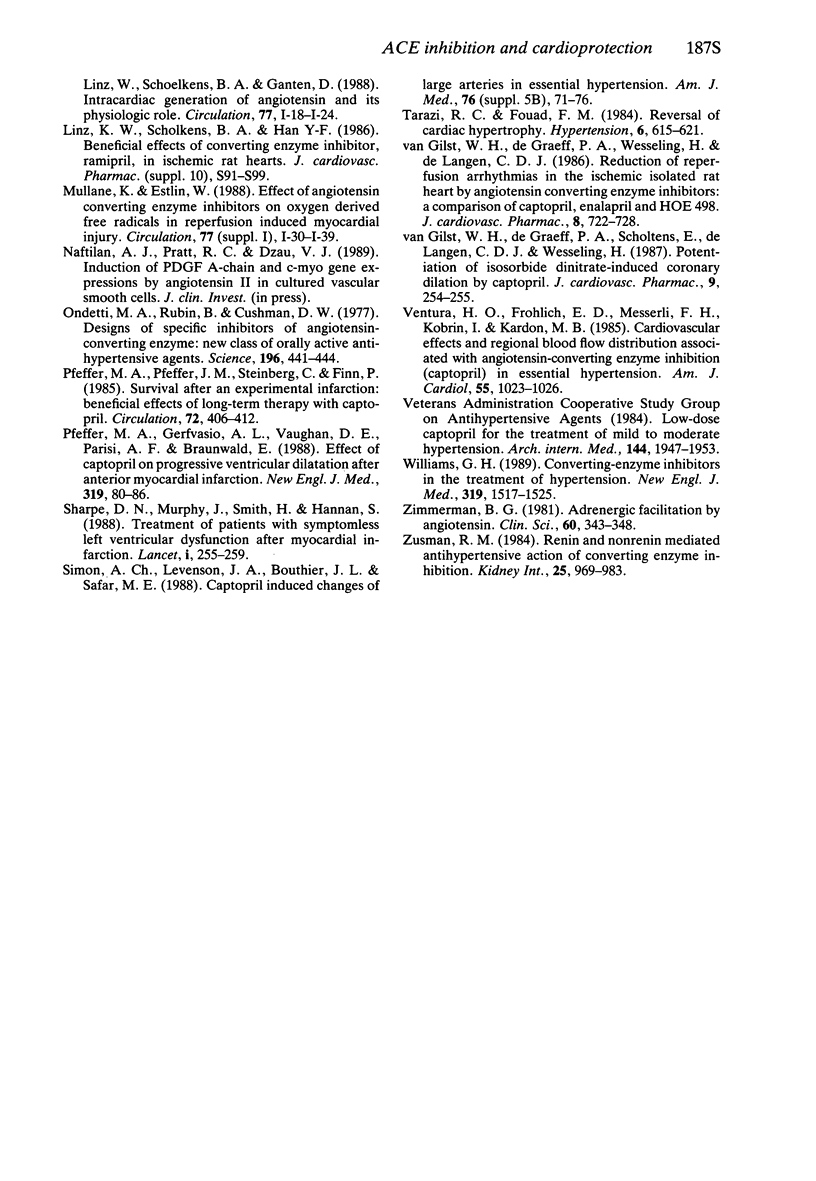Abstract
1 The circulating and tissue renin-angiotensin systems (RAS) contribute importantly to cardiovascular homeostasis. Systemic and/or local activation of the RAS is seen in many pathological conditions of the cardiovascular system (e.g. hypertension and congestive heart failure). Increased angiotensin production participates in the pathophysiology of these and other disease states. Accordingly, inhibitors of the renin angiotensin system have a broad spectrum of therapeutic efficacy.
2 Angiotensin-converting enzyme (ACE) inhibitors are effective antihypertensive agents that do not adversely affect serum lipid levels. In addition, they reduce left ventricular hypertrophy.
3 ACE inhibitors cause coronary vasodilation and reduce ventricular work and wall stress. They have been shown to reduce experimental infarct size and to increase anginal threshold in humans.
4 After experimental or human myocardial infarction that results in significant left ventricular dysfunction, ACE inhibitors prevent ventricular dilatation and development of congestive heart failure, and may improve survival.
5 ACE inhibitors can prevent ventricular fibrillation and contractile impairment (stunned myocardium) associated with reperfusion injury after experimental myocardial ischaemia.
6 ACE inhibitors reduce preload and afterload, improve exercise capacity, reduce ventricular arrhythmias, and improve patient survival in clinical cardiac failure.
7 Taken together, inhibition of the RAS may potentially result in primary as well as secondary protective effects on the cardiovascular system.
Keywords: ACE inhibition, cardioprotection, cardiovascular pharmacology, renin angiotensin system
Full text
PDF




Selected References
These references are in PubMed. This may not be the complete list of references from this article.
- Campbell-Boswell M., Robertson A. L., Jr Effects of angiotensin II and vasopressin on human smooth muscle cells in vitro. Exp Mol Pathol. 1981 Oct;35(2):265–276. doi: 10.1016/0014-4800(81)90066-6. [DOI] [PubMed] [Google Scholar]
- Cleland J. G., Dargie H. J., Ball S. G., Gillen G., Hodsman G. P., Morton J. J., East B. W., Robertson I., Ford I., Robertson J. I. Effects of enalapril in heart failure: a double blind study of effects on exercise performance, renal function, hormones, and metabolic state. Br Heart J. 1985 Sep;54(3):305–312. doi: 10.1136/hrt.54.3.305. [DOI] [PMC free article] [PubMed] [Google Scholar]
- Croog S. H., Levine S., Testa M. A., Brown B., Bulpitt C. J., Jenkins C. D., Klerman G. L., Williams G. H. The effects of antihypertensive therapy on the quality of life. N Engl J Med. 1986 Jun 26;314(26):1657–1664. doi: 10.1056/NEJM198606263142602. [DOI] [PubMed] [Google Scholar]
- Daly P., Mettauer B., Rouleau J. L., Cousineau D., Burgess J. H. Lack of reflex increase in myocardial sympathetic tone after captopril: potential antianginal effect. Circulation. 1985 Feb;71(2):317–325. doi: 10.1161/01.cir.71.2.317. [DOI] [PubMed] [Google Scholar]
- Dzau V. J., Burt D. W., Pratt R. E. Molecular biology of the renin-angiotensin system. Am J Physiol. 1988 Oct;255(4 Pt 2):F563–F573. doi: 10.1152/ajprenal.1988.255.4.F563. [DOI] [PubMed] [Google Scholar]
- Dzau V. J. Implications of local angiotensin production in cardiovascular physiology and pharmacology. Am J Cardiol. 1987 Jan 23;59(2):59A–65A. doi: 10.1016/0002-9149(87)90178-0. [DOI] [PubMed] [Google Scholar]
- Dzau V. J. Significance of the vascular renin-angiotensin pathway. Hypertension. 1986 Jul;8(7):553–559. doi: 10.1161/01.hyp.8.7.553. [DOI] [PubMed] [Google Scholar]
- FERREIRA S. H. A BRADYKININ-POTENTIATING FACTOR (BPF) PRESENT IN THE VENOM OF BOTHROPS JARARCA. Br J Pharmacol Chemother. 1965 Feb;24:163–169. doi: 10.1111/j.1476-5381.1965.tb02091.x. [DOI] [PMC free article] [PubMed] [Google Scholar]
- Geisterfer A. A., Peach M. J., Owens G. K. Angiotensin II induces hypertrophy, not hyperplasia, of cultured rat aortic smooth muscle cells. Circ Res. 1988 Apr;62(4):749–756. doi: 10.1161/01.res.62.4.749. [DOI] [PubMed] [Google Scholar]
- Kannel W. B., Gordon T., Castelli W. P., Margolis J. R. Electrocardiographic left ventricular hypertrophy and risk of coronary heart disease. The Framingham study. Ann Intern Med. 1970 Jun;72(6):813–822. doi: 10.7326/0003-4819-72-6-813. [DOI] [PubMed] [Google Scholar]
- Kiowski W., Burkart F. Effects of vasodilators on the coronary circulation in congestive heart failure. Am J Cardiol. 1988 Sep 9;62(8):99E–103E. doi: 10.1016/s0002-9149(88)80021-3. [DOI] [PubMed] [Google Scholar]
- Kleber F. X. Einfluss von Captopril auf die Lebenserwartung bei Patienten mit chronischer Herzinsuffizienz. Herz. 1987 Dec;12 (Suppl 1):38–45. [PubMed] [Google Scholar]
- Linz W., Schölkens B. A., Han Y. F. Beneficial effects of the converting enzyme inhibitor, ramipril, in ischemic rat hearts. J Cardiovasc Pharmacol. 1986;8 (Suppl 10):S91–S99. doi: 10.1097/00005344-198600101-00017. [DOI] [PubMed] [Google Scholar]
- Ondetti M. A., Rubin B., Cushman D. W. Design of specific inhibitors of angiotensin-converting enzyme: new class of orally active antihypertensive agents. Science. 1977 Apr 22;196(4288):441–444. doi: 10.1126/science.191908. [DOI] [PubMed] [Google Scholar]
- Pfeffer M. A., Lamas G. A., Vaughan D. E., Parisi A. F., Braunwald E. Effect of captopril on progressive ventricular dilatation after anterior myocardial infarction. N Engl J Med. 1988 Jul 14;319(2):80–86. doi: 10.1056/NEJM198807143190204. [DOI] [PubMed] [Google Scholar]
- Pfeffer M. A., Pfeffer J. M., Steinberg C., Finn P. Survival after an experimental myocardial infarction: beneficial effects of long-term therapy with captopril. Circulation. 1985 Aug;72(2):406–412. doi: 10.1161/01.cir.72.2.406. [DOI] [PubMed] [Google Scholar]
- Sharpe N., Murphy J., Smith H., Hannan S. Treatment of patients with symptomless left ventricular dysfunction after myocardial infarction. Lancet. 1988 Feb 6;1(8580):255–259. doi: 10.1016/s0140-6736(88)90347-9. [DOI] [PubMed] [Google Scholar]
- Simon A. C., Levenson J. A., Bouthier J. L., Safar M. E. Captopril-induced changes in large arteries in essential hypertension. Am J Med. 1984 May 31;76(5B):71–75. doi: 10.1016/0002-9343(84)90888-x. [DOI] [PubMed] [Google Scholar]
- Ventura H. O., Frohlich E. D., Messerli F. H., Kobrin I., Kardon M. B. Cardiovascular effects and regional blood flow distribution associated with angiotensin converting enzyme inhibition (captopril) in essential hypertension. Am J Cardiol. 1985 Apr 1;55(8):1023–1026. doi: 10.1016/0002-9149(85)90739-8. [DOI] [PubMed] [Google Scholar]
- Williams G. H. Converting-enzyme inhibitors in the treatment of hypertension. N Engl J Med. 1988 Dec 8;319(23):1517–1525. doi: 10.1056/NEJM198812083192305. [DOI] [PubMed] [Google Scholar]
- Zimmerman B. G. Adrenergic facilitation by angiotensin: does it serve a physiological function? Clin Sci (Lond) 1981 Apr;60(4):343–348. doi: 10.1042/cs0600343. [DOI] [PubMed] [Google Scholar]
- Zusman R. M. Renin- and non-renin-mediated antihypertensive actions of converting enzyme inhibitors. Kidney Int. 1984 Jun;25(6):969–983. doi: 10.1038/ki.1984.119. [DOI] [PubMed] [Google Scholar]
- van Gilst W. H., de Graeff P. A., Scholtens E., de Langen C. D., Wesseling H. Potentiation of isosorbide dinitrate-induced coronary dilatation by captopril. J Cardiovasc Pharmacol. 1987 Feb;9(2):254–255. doi: 10.1097/00005344-198702000-00021. [DOI] [PubMed] [Google Scholar]
- van Gilst W. H., de Graeff P. A., Wesseling H., de Langen C. D. Reduction of reperfusion arrhythmias in the ischemic isolated rat heart by angiotensin converting enzyme inhibitors: a comparison of captopril, enalapril, and HOE 498. J Cardiovasc Pharmacol. 1986 Jul-Aug;8(4):722–728. [PubMed] [Google Scholar]


